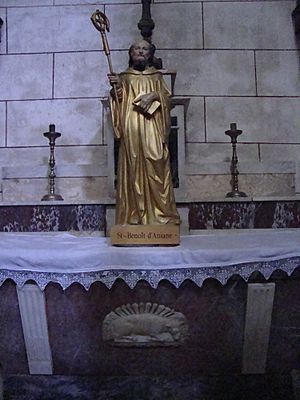Benedict of Aniane facts for kids
Quick facts for kids SaintBenedict of Aniane |
|
|---|---|
 |
|
| Born | 747 Kingdom of the Franks |
| Died | 12 February 821 |
| Venerated in | Eastern Orthodox Church Roman Catholic Church |
| Feast | 12 February |
Saint Benedict of Aniane (born Witiza, around 747 AD – February 12, 821 AD) was a very important Benedictine monk. He was known as the "Second Benedict" because he helped improve how monasteries worked in the Carolingian Empire. His special day, called a feast day, is celebrated on February 11 or 12.
Contents
Life Story of Benedict
Early Life and Royal Service
Benedict was born Witiza, the son of a Visigoth count named Aigulf. He grew up and was educated at the royal court of Pippin the Younger, who was a king of the Franks. Later, he served at the court of Charlemagne, a very powerful emperor.
In 773, Benedict went with Charlemagne on a military trip to Italy. During this trip, he almost drowned in the Ticino River while trying to save his brother. This scary experience made him decide to leave his royal service and become a monk. He joined the Abbey of Saint-Seine.
Becoming a Monk and Reformer
At Saint-Seine, Benedict first worked as a cellarer, managing the monastery's supplies. Later, he was chosen to be the abbot, or head, of the monastery. However, the other monks did not want to follow his very strict rules. So, Benedict left and went back to his family's land in Languedoc.
Around 780, he started a new religious community there. At first, it was based on a very strict, simple way of life. But in 782, he founded another monastery in the same place, this time following the Benedictine Rule. This rule was a set of guidelines for monks created by Saint Benedict.
Benedict's new monastery was very successful. This success gave him a lot of influence. He used this influence to start and improve many other monasteries. Eventually, he became like the main abbot for all the monasteries in Charlemagne's empire.
Working with Emperor Louis the Pious
In 781, Louis the Pious became the King of Aquitaine. He asked Benedict to help improve the monasteries in his area. Later, when Louis became emperor, he trusted Benedict to help all the monasteries in his empire work together and follow the same practices. Benedict knew a lot about early Christian writings, and important church leaders like Alcuin often asked him for advice.
In 814, Emperor Louis asked Benedict to build a new monastery near the royal court in Aachen. This monastery was first called the "Monastery of the Redeemer on the Inde." It later became known as Kornelimünster Abbey.
Creating Rules for Monasteries
Benedict led a group of abbots at a meeting in Aachen in 817. They created a set of rules called the "Codex regularum." These rules were meant to be followed by all monasteries. Benedict wanted to bring back the original, strict way of life for monks, especially where it had become too relaxed.
Soon after, he put together another book called the "Concordia regularum." This book showed how the Benedictine Rule agreed with other monastic rules. This helped people respect the Benedictine Rule even more. Benedict was a dedicated church leader who used his knowledge to support correct religious beliefs and the Benedictine way of life.
Although these new rules were not used much after Benedict and Emperor Louis died, they had a lasting impact on how monasteries developed in Western Europe.
Death and Legacy
Benedict died at Kornelimünster Abbey on February 11, 821. This was the monastery Louis had built for him. He was buried the next day, February 12. This is why some people celebrate his feast day on the 11th and others on the 12th.
Benedict's Writings
- Codex regularum monasticarum et canonicarum: This is a collection of rules for monks and other religious people. You can find it in a large collection of writings called Patrologia Latina.
- Concordia regularum: This book compares the Benedictine Rule with other monastic rules, showing how they are similar.
- Letters: Benedict also wrote many letters.
Other writings that are sometimes said to be by him are probably not real.
See also
 In Spanish: Benito de Aniane para niños
In Spanish: Benito de Aniane para niños
- Saint Benedict of Aniane, patron saint archive

